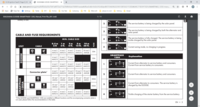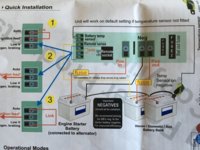thank you travelvoltsBe sure to change the 100 amp fuses for something more appropriate to your charger. Also note that this diagram does not show an earth bonding between the consumer unit and van body. There has to be one.
i am going to replace the wiring setup from the main vehicle battery to leisure battery from 16mm2 (110a) wire to 10mm2 (70a) wire and change the 100amp fuses for 30amp fuses. My reason for this is thinking that the wiring setup on the diagram i linked is a big overkill and such high amp is not needed as it wont draw that much. I will also be adding a earth bond to the consumer unit as you mentioned. i noticed this when i did my previous van.. do you think its ok to drop the wire and fuses to the amps i mention. i am going off advice from a electrician but i wanted to ask for a few opinions before doing this.. i am fitting the CTEKd250se charger to my system. if you have time would you mind taking a look at the manual for it i have linked
https://www.ctek.com/storage/ma/66f...7B39F70D1/SMARTPASS_120S-manual-low-UK-EN.pdf
thanks in advance
Vee




